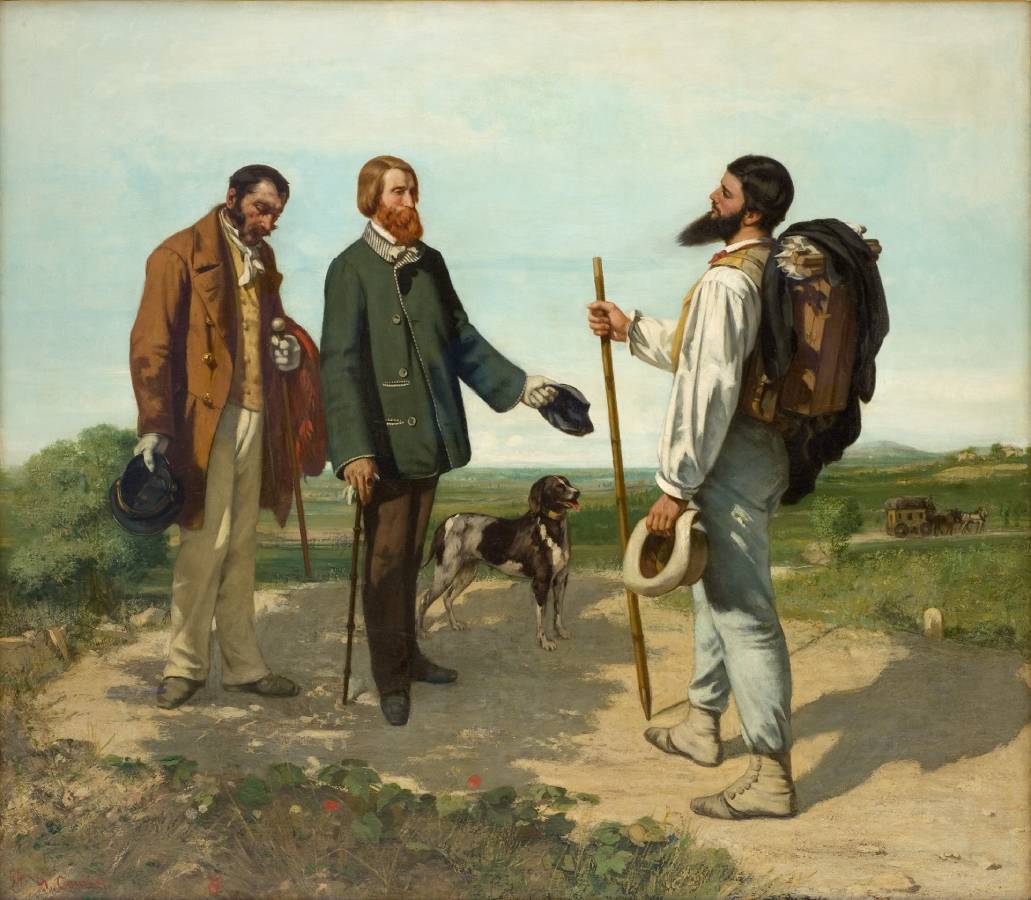Courbet, Gustave (1819-1877)
La Rencontre ou Bonjour Monsieur Courbet (The Meeting or Hello M. Courbet)
1854
Oil on canvas, 132.40 x 151 cm
Musée Fabre, Montpellier
Montpellier, painted by the artist for Alfred Bruyas (1821-1877), 1854; gift from Alfred Bruyas to the Fabre museum, 1868.
Created by Courbet during his stay in Montpellier in 1854, La Rencontre embodies the pact sealing the friendship of the patron and the artist. Revealed to the public during the Universal Exhibition of 1855, the painting became immensely famous under the title of Hello, Monsieur Courbet!
Universally famous, a true icon of 19th century French art, La Rencontre immortalizes the painter’s arrival in Montpellier in May 1854. Courbet had left the stagecoach a little before the city and met his host accompanied by his servant Calas and the Breton dog. The scene is located not far from the home of Émile Mey (a friend of Bruyas) a few kilometers from Montpellier, at the intersection of the road to Sète and the road to Saint-Jean-de-Védas in Lattes, towards from Mireval. In reality, Courbet took the recent railway line and his light clothing and painter’s paraphernalia rather suggest that he was returning from a day’s excursion to the motif. Topographical indications remain vague and difficult to identify. As most commentators have noted, this meeting clearly takes place “on the terrain of art”.
The painting is a continuation of the purchases and orders of the previous year, in particular the Tableau-Solution which established a true pact of friendship and collaboration between the artist and the collector. The clear and effective composition according to a tripartite diagram inherited from neoclassicism depicts the puny collector, aged thirty-three, dressed in an elegant dark green peacoat and followed by his servant, confronted by the robust worker, two years his senior. Courbet, although shifted to the right, in profile, has given himself the beautiful role with his light coat which catches the light, the beautiful dark head, the “Assyrian” beard silhouetted against the sky, and the staff firmly anchored in the soil which gives him the appearance of an apostle of new times, impatient to “begin in the great wandering and independent life of the bohemian” (Francis Wey).
The two men, almost on an equal footing, suggest the bond of interdependence that unites them: Bruyas needs the painter in whom he has recognized the superior qualities to create the works for which he has a project; Courbet, aware of his value, needed the emotional and financial support of the Montpellier resident, a wealthy man of taste.
By elevating to the rank of history painting a private, ultimately banal, news item, Courbet continued his work of undermining and overturning established hierarchies. The theme of the meeting also had a rich iconography, particularly religious, that Courbet could not ignore (Eliezer and Rebecca; Solomon and the Queen of Sheba; Visitation of the Virgin Mary, etc.).
The general outline of the composition was suggested to him by a popular print, The Burghers of the City Speaking to the Wandering Jew, engraved by Pierre Leloup of Le Mans in 1831. His friend Champfleury used it as a frontispiece of his fundamental work published in 1869, History popular imagery. Through Champfleury, discoverer of the Le Nain brothers, Courbet was able to come into contact with their art in which we already find hieratic silhouettes, as if standing still, “monumentalized” in front of the vast Picardy plain. Courbet‘s trip to Holland in 1846, so decisive for the affirmation of his realism, provided him with many examples, particularly through the landscapes of Albert Cuyp (1620-1691). To these probable sources, it is appropriate to add the extraordinary evocative power of the colored paste: fluid, loose with tasty impastos which preserve the freshness of the sketch on the motif or on the contrary solid and firm, depending on the teaching from Dutch or Spanish masters whom Courbet admired.
The painting became legendary when it was presented at the Universal Exhibition of 1855; it “has an extraordinary effect” according to the painter and provokes the verve of the caricaturists and the anger of the critics. Bruyas, injured, withdrew the painting from public view until its donation to the Fabre museum in 1868. Finally, Théodore de Banville, parodying Victor Hugo, was inspired by Courbet‘s painting in one of the Funambulesque Odes:
“And the dark foliage hollowed out like a hanger,
The lawns, the branch curved by a potbelly fruit,
Singed: “Hello, Monsieur Courbet
the master painter!
Mr Courbet, hello! Hello, Mr. Courbet!” » (FABRE)
